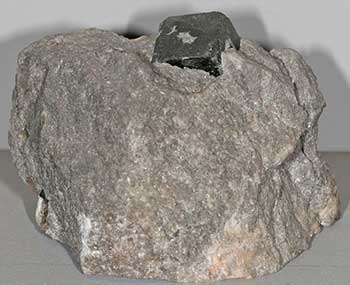 |
| Boracite - Mg3B7O13Cl. |
Boron is a semi-metallic element, exhibiting some properties of a metal and some of a non-metal. Its atomic number is 5 and its chemical symbol is B. In elemental form it is a dark, amorphous, unreactive solid. (An amorphous substance is one that does not form crystals.)
Boron is used mainly not as the element boron, but as compounds of boric oxide (B2O3) and boric acid (H3BO3). Most people have never seen elemental boron.
Name
Boron was named for the mineral borax, thought to come from the Persian name burah for that mineral. Boron minerals, mainly borax, were traded over a thousand years ago, when sheep, camel and yak caravans brought borax from desert salt beds in Persia and Tibet to India and the Arab countries. There it was used mainly in making glass.
The element boron was not identified and isolated until 1808, when Sir Humphrey Davy of England, and Joseph-Louis Gay-Lussac and Louis Jacques Thenard of France, discovered that boron could be produced by combining boric acid (H3BO3) and metallic potassium.
Sources
The major ores of boron are a small number of borate (boron oxide) minerals, including ulexite (NaCaB5O9.8H2O), borax (Na2B4O5(OH)4.8H2O), colemanite (Ca2B6O11.5H2O) and kernite (Na2B4O6(OH)2.3H2O). These minerals form when boron-bearing waters percolate into inland desert lakes and evaporate, leaving layers of borates, chlorides, and sulfates. These minerals are referred to as evaporite minerals. Very large deposits of evaporite boron minerals are found in the United States (especially California), Turkey, Chile and Argentina. Less-important deposits occur in Iran (formerly called Persia), and elsewhere.In addition, boron silicate minerals are mined as boron ores in China, Russia, and a few other countries.
Turkey, the United States and Russia are the largest producers of boron minerals. Argentina, Chile, and China have important ore production, and five or six other countries produce minor amounts. The U.S. production is all from the deserts of southeastern California.
In addition to its own production, the United States imports borate minerals and processed compounds, and exports a large amount of finished products containing boron.
Uses
Boron compounds are used for many different purposes in industry and the home. In the United States, boron is used to make glass, ceramics, and enamels, including fiberglass for insulation.
Boron compounds are used to make water softeners, soaps and detergents. Other uses are in agricultural chemicals, pest controls, fire retardants, fireworks, medicine, and various minor applications.
Boron is a chemical used to make boron nitride, one of the hardest known substances, for abrasives and cutting tools.
The effect of boron on animals is under study. There is no evidence that boron is necessary for animal health, although in small quantities it might stimulate bone and muscle growth. On the other hand, it is an essential trace element for green algae and higher plants used in agriculture.
Substitutes and Alternative Sources
In detergents, boron compounds can be replaced with chlorine and enzymes. Lithium compounds can be used to make enamels and glass products. However, the known boron ores in the world should easily meet the world demand for boron compounds for many years to come.